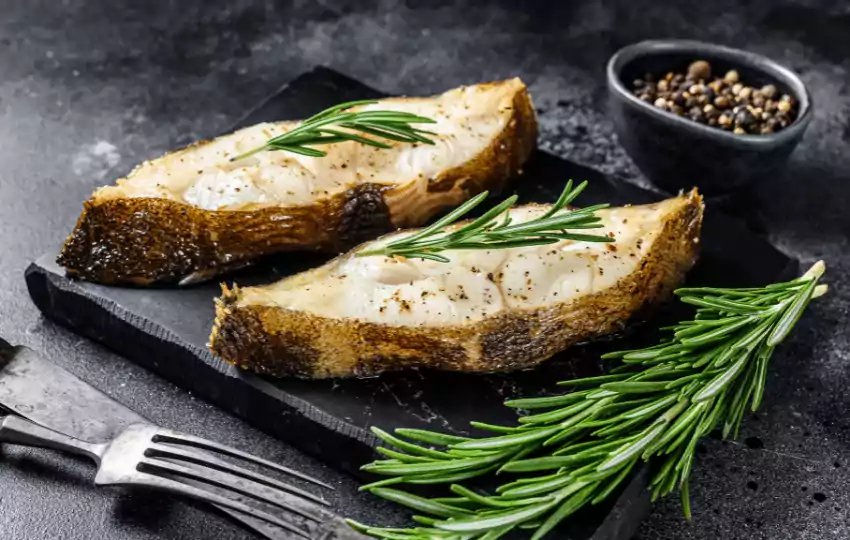Are you looking for a delicious, nutritious, and sustainable seafood option for your restaurant or home kitchen? Halibut fillet may be just the thing you’re looking for, but unfortunately, this dish can be quite expensive.
If you’re searching to save some money without sacrificing flavor or nutrition, consider using one of these cheaper but equally delicious alternatives to Halibut substitutes either for fillet or cheeks.
Halibut is a delicious, mild-tasting white fish that can be prepared in many different ways. We can pan-sear the halibut fillets and serve them with a sweet and sour sauce. This recipe is fast and simple to create; it’s sure to please your taste buds! This versatile fish can be pan-fried, grilled, or baked.
Here are some of our favorites.
What is Halibut?
Halibut is a kind of flatfish that is found in the colder waters of the North Atlantic and North Pacific oceans. It is one of the largest flatfish, with some individuals reaching up to 2.5 m (8 ft 2 in) long and weighing as much as 150 kg (330 lb).
The fish has a brown or black upper body with a white underbelly and is distinguished by its long, tapered body shape. Halibut are bottom-dwelling fish and prefer to live in waters that are between 40 and 200 m (130 and 660 ft) deep.
What does halibut fish taste like?
When it comes to taste, halibut has a mild flavor with a slightly sweet taste. The flesh is firm and has a large, flaky texture. Halibut is a multipurpose fish that can be cooked in a variety of ways, including baking, grilling, frying, and poaching.
Halibut Uses
If you’re looking for ways to add halibut to your culinary repertoire, try incorporating it into various dishes, such as fish tacos, soups, stews, casseroles, and salads.
You can also make halibut burgers or fish cakes for a quick and easy meal. When buying halibut fillets or steaks, look for ones that are firm and free from any discoloration or blemishes.
Also, try poaching the fish in a white wine sauce. To do this, start by heating some oil or butter in a large skillet over medium-high heat. Next, add the halibut fillets to the pan and cook until golden brown on both sides, about 3–4 minutes per side.
Release the fish from the pan, and add some white wine, lemon juice, and garlic to the pan. Let this mixture simmer for about 2–3 minutes, or until reduced by half.
Return the fish to the pan, along with some chopped parsley or tarragon. Next, cook for a further 1–2 minutes, remove from the heat and serve immediately. Enjoy!
So…
What fish can you substitute for halibut?
There are many options for an alternative to halibut, from cheap to expensive, like Tilapia, Haddock, Cod, Sole, flounder, sea bass, fluke, striped bass, black pomfret, turbot, dogfish, orange roughy, and mahi-mahi. These are all well known and easy to find, and similar in taste to halibut.
Let’s look over the substitutes in detail.
Best halibut Substitutes
1. SOLE- a good substitute for halibut
The sole fish is a type of flatfish that lives on the ocean floor. Soles are found in both temperate and tropical drinks of water around the world. These fish get their name from their flattened bodies, which help them to blend in with the sand and other debris on the ocean floor.
Most sole species are bottom-dwellers, meaning that they spend their time near the ocean floor.
The sole and halibut are both types of flatfish with flaky, white meat that is prized for its flavor and texture. Like halibut, the sole is often fried or baked and is frequently served with a lemon sauce.
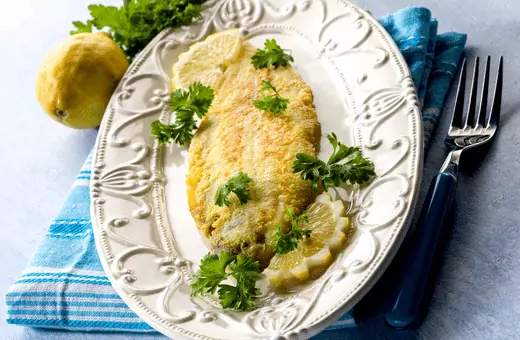
Although, halibut is slightly firmer in texture than sole and has a more mild flavor.
You can have fried or baked, and sometimes served with a lemon sauce. Some of the most popular sole dishes include sole meunière, sole almandine, and pan-fried sole.
The majority of the world’s sole catch comes from the North Sea, where species such as Dover sole (Solea solea) and lemon sole (Microstomus kitt) are fished commercially.
California is the biggest producer of farmed sole in the United States, with species such as Petrale sole and rex sole being commercially raised in the state.
2. FLOUNDER- Suitable Substitution for Halibut Fillet
In the next option, one of our favorite baked fish, while we don’t find halibut, is flounder.
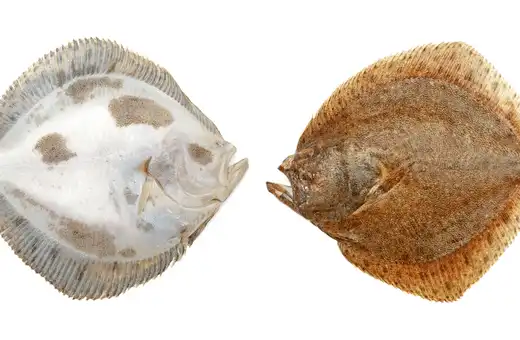
Flounders are a type of flatfish that live at the bottom of the ocean. Flounders are excellent swimmers and can change color to match their surroundings. Some species of flounder can walk on their fins to move around in the shallow waters.
Adult flounders can weigh up to 13 pounds and measure 30 inches in length. They live for about 20 years and prefer to eat shrimp, small fish, and squid.
Flounders are found in all oceans across the world. In the United States, they are most common along the east coast from Maine to Florida. Some of the most popular types of flounder include the winter flounder, summer flounder, and lemon sole.
Flounder is a popular type of seafood and is often served fried, baked, or grilled. It is a lean source of protein that is low in calories and fat. In fact, a 3-ounce serving of flounder contains only 87 calories and 1.3 grams of fat!
Although there are some minor differences in taste and culinary preparation, flounder and halibut share many similarities. Both are white-fleshed, mild-flavored fish that can be enjoyed grilled, sautéed, poached, or baked.
Flounder is slightly more delicate than halibut, but they both have firm, tender flesh that cooks up nicely.
3. Tilapia – cheaper substitute for halibut
Are you on a tight budget? Then try tilapia instead of halibut in different ways, including grilling, baking, frying, or steaming.
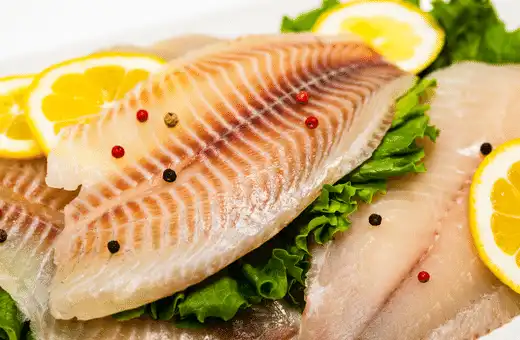
Tilapia is a popular fish choice with consumers due to its desirable taste, culinary use, and rich nutritional profile. Tilapia has a mild flavor that is not too strong or overpowering, making them suitable for many different types of dishes.
Tilapia also has a number of nutritional benefits due to its high content of protein and omega-3 fatty acids. These nutrients are important for maintaining good heart health as well as promoting healthy brain development in children.
Additionally, tilapia contains key vitamins and minerals such as vitamin D and calcium, which are essential for bone health.
Tilapia and halibut are very similar, particularly in terms of taste and culinary uses. Additionally, tilapia tends to hold their shape well when cooked, which makes them ideal for dishes where you want the fish to be a prominent ingredient.
Overall, if you enjoy rich, flavorful fish dishes, tilapia is an excellent choice for your culinary repertoire. Suppose you’re searching for a fast weeknight dinner or a special-occasion dish. In that case, these fish will surely deliver an exceptional dining experience.
4. Substitute Cod for Halibut – A Great Decision
Cod is a versatile fish with a mild flavor that can be used in a variety of dishes. It is a good source of protein and omega-3 fatty acids, making it a healthy option for people looking to add more seafood to their diet.
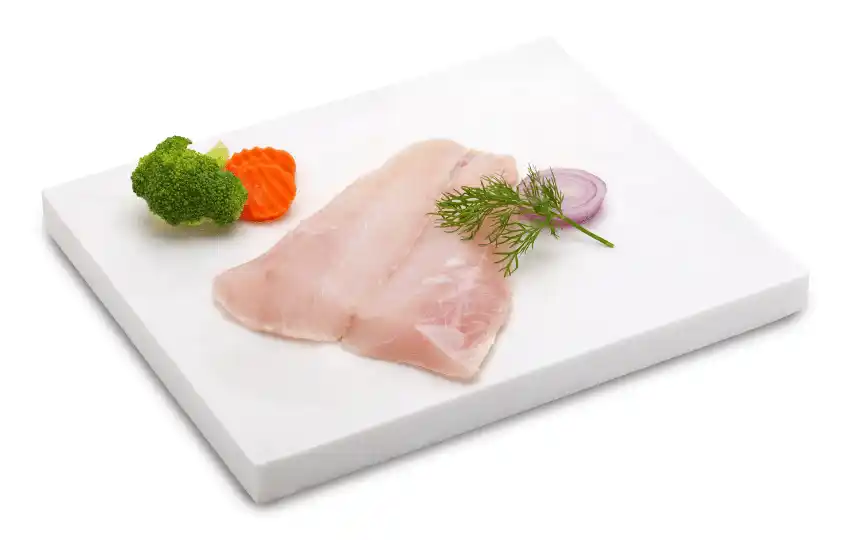
When it comes to cooking cod, there are many different options. Some of the most popular preparations include baking, frying, and grilling. Cod is also commonly used as an ingredient in soups, chowders, casseroles, fish cakes, fish tacos, and seafood pasta dishes. Cod is similar to Hake.
Whether you are preparing cod for yourself or for a group of people, it is important to choose high-quality fish from a reputable source. This will ensure that you get the most nutrients out of your meal and avoid any potential contaminants.
Cod are mild-flavored, firm-textured white fish like halibut that are popular in many cultures. They can be produced in various methods, including baking, frying, grilling, and steaming.
5. Sometimes, I substitute Sea Bass for halibut
Sea basses are one of the most sought-after types of fish in cuisine. It has a mild and delicate taste that makes it perfect for almost all dishes.
You can also use sea bass to make a variety of soups, salads, and desserts. If you want to buy or catch your own sea bass, then you need to know when they are in season. The best time to harvest sea bass is during the months of May and June.
Sea bass is white fish with a mild flavor, just like halibut. Although, I found sea bass sweeter than halibut. The best part of Sea bass is commonly used in raw preparations, such as ceviche or sashimi, while halibut can be pan-seared, poached, or baked.
6. Substitute haddock for halibut – Taste Similar To Halibut
Do you like haddock? So, why don’t you try to replace halibut?
Haddock has a mild, slightly sweet taste that is similar to cod. This makes it a versatile fish that can be used in many different types of dishes. Haddock is often used in British and Scandinavian cuisine. It can be baked, fried, poached, or grilled. Haddock is also a popular fish for making fishcakes and fish pies.

Haddock and halibut are both white fish that has a mild flavor. They can be utilized interchangeably in most recipes. Haddock is typically cheaper than halibut, making it a good choice for budget-conscious cooks.
When frying or grilling, haddock tends to be more moister than halibut. Halibut, on the other hand, has a flakier texture when baked or pan-seared.
Haddock can be prepared in many ways, depending on the cooking method you prefer. The most famous methods are baking, grilling, frying, searing, and poaching. Haddock is often breaded and fried, while halibut can be pan-seared or grilled.
When shopping for haddock, look for fish that has bright white flesh and is free of dark spots. Also, the fish should be firm to the touch and have a fresh, ocean-like smell. Avoid fish that has a strong fishy odor. Haddock are usually sold as fillets, steaks, or whole fish.
Also, When cooking haddock, be sure to not overcook the fish. Overcooked fish can become dry and rubbery. Try them in fish tacos, fish & chips, fish sandwiches, or simply grilled with a side of vegetables. No matter how you prepare them, haddock is sure to be a delicious addition to any meal!
7. Fluke- Decent Replacement for Halibut
Another good halibut substitute is a fluke. Fluke has a delicate, slightly sweet taste that is often compared to that of scallops. It is commonly used in Japanese and Korean cuisine, where it is typically prepared as sashimi or sushi.
In Korea, fluke is also popularly grilled or pan-fried. In addition to being eaten raw, fluke can also be cooked in a variety of ways, including steaming, boiling, and frying.
Fluke is a good source of protein, vitamin B12, phosphorus, and selenium. It is also low in calories and fat. Additionally, fluke is quite tender and does not require a long cooking time. This makes it an excellent ingredient for numerous different types of cuisine, as well as healthy recipes such as sauces and salads.
One of the main similarities between haddock and halibut is their taste. Both fish are relatively mild in flavor, with a slight sweetness that can be enhanced by cooking methods such as grilling or frying.
In addition, fluke is commonly used in seafood dishes like chowders, curries, and other stews due to its versatility and hearty texture.
If you are interested in trying this deliciously versatile seafood, you can easily find fluke at most local grocery stores or fish markets.
8. Striped Bass
While Striped Bass and Halibut may not look all that similar, they actually have quite a bit in common when it comes to taste and culinary uses. Both fish have a mild, slightly sweet flavor that is well-suited to a variety of different seasonings and sauces.
The striped bass is basically a saltwater fish that can be found in the western Atlantic Ocean, specifically around the coastal regions of North America.
The fish is also known by a number of other names, including rockfish, striper, and linesider. The striped bass is famous for both its taste and its use in culinary dishes.
The striped bass has a light to dark olive green-colored back and white-colored abdomen. They have a wide body that extends from the head to the tail.
The striped bass is able to reach up to two meters in length, though most typically only grow to be between thirty-five and forty centimeters long when fully grown.
The striped bass is a popular choice for culinary use due to its delicate flavor, which has been described as both sweet and light. It is commonly used in dishes like ceviche and sushi, but it can also be used in a variety of other ways, such as baked, fried, or served on the grill.
When you try to cook with striped bass for the first time, there are a few things to keep in mind.
· First, it is necessary to make sure that the fish is properly cleaned and scaled before cooking.
· Second, the flesh of the fish can be quite delicate, so it is important to use a gentle cooking method, such as baking or poaching, to avoid overcooking the fish and making it tough.
· Striped bass lends itself well to a variety of seasonings, so feel free to experiment and find new flavor combinations that you enjoy.
When it comes to cooking methods, additionally, Striped Bass are quite versatile, you can grill, bake, pan-seared, or poach – making them ideal for a wide range of recipes.
Striped bass cooks a bit faster, making it ideal for recipes that require minimal cooking time, such as pan-searing or grilling.
9. Black Pomfret- Australian fish substitute for halibut
Black Pomfret is Known as Australian halibut. One of the most famous methods of cooking Black Pomfret is to fry it. This can be done by marinating the fish in a mixture of spices and then coating it in a batter before frying it. The result is a crispy and tasty fish that can be served with rice or noodles.
Another popular way to cook Black Pomfret is to steam it. This is done by placing the fish in a steamer and cooking it until the flesh is cooked through. This method of cooking supports retaining all of the nutrients in the fish and makes it more healthy.
Black Pomfret can also be baked. This is done by marinating the fish in a mixture of spices and herbs, then baking it in the oven until it is lightly crispy. This makes a flavorful dish that can be served with rice or noodles.
10. Turbot -Another Reasonable Alternative to Halibut
Turbot and halibut are both white fish with a firm, flaky texture and mild flavor that lends well to many different types of cooking. Because of these similarities in taste and culinary uses, they are often used interchangeably in recipes.
Turbo is a seafood that is popular in many parts of the world. It is often considered a delicacy, and its meat is used in a variety of dishes. Turbo can be found in the Mediterranean, Atlantic, and Pacific oceans. It is also known as the “Turbinella pugilina”.
The taste of turbo is often described as similar to scallops. It can also be somewhat chewy, but it has a unique and pleasant flavor that really stands out in many dishes. Turbo is often used in soups and stews, where its appealing texture adds just the right amount of body and chewiness to the dish.
Turbo is also popularly used as an ingredient in sushi and sashimi. Its firm texture and delicate flavor make it a perfect complement to the other ingredients in these Japanese dishes.
If you’re looking for seafood that is both delicious and unique, turbo is definitely worth trying! Its delicate flavor and firm texture make it a great choice for substituting halibut.
11. Dogfish – Best Halibut steak substitute
Dogfish is a kind of shark found in marine waters around the world. It has a unique taste and is commonly used to add flavor to different dishes. Overall, it can be considered an important ingredient in many culinary preparations.
Some even use dried dogfishes for flavoring their dishes. In addition, its oil is used in several cosmetic products as well.
The taste of dogfish is rather mild, and it can be compared to that of a white fish. Its flesh contains very little fat, making it an ideal choice for people who are diet-conscious. The meat is also soft and flaky when cooked, which makes it easy to use in recipes.
You could bake or poach dogfish, although the best way to cook it is by grilling. Because of its unique flavor, it goes well with other ingredients like lemon juice, soy sauce, and garlic.
In Japan, it is believed to be a delicacy and used in many traditional recipes. It is even available at some of the local sushi restaurants.
12. ORANGE ROUGHY- Expensive Replacement
If you don’t have a budget limit, then try once orange roughy; though it is more expensive than halibut, the taste always craving for it.
The orange roughy is a popular fish that has a mild, buttery taste. It can be used in many different ways in the kitchen and is considered to be one of the best-tasting fish out there.
Even use it as an alternative to lobster and crab for things like seafood cakes and chowders. Its flesh holds up well to cooking and has a nice, firm texture. It’s also a good fish for people who are looking for a lower-fat option, as it is relatively lean.

When buying orange roughy, make sure to look for fillets that are pinkish-orange in color and have been properly refrigerated. Avoid any that look dull or have dark spots, as these are signs of spoilage.
Orange roughy is best cooked using methods that don’t dry out the fish, such as baking, broiling, poaching, or steaming.
You can also be pan-fried, but make sure not to overcook it. If you’re searching for a healthy and delicious way to prepare orange roughy, try this recipe for orange roughy with lemon and herbs. This dish is full of flavor and is also relatively low in calories.
13. You can Substitute MAHI MAHI for Halibut
Mahi-mahi is a multipurpose fish that can be used in many different dishes. Its mild flavor pairs well with a variety of seasonings and sauces, making it an excellent choice for home cooks and professional chefs alike.
It is often served fried, grilled, barbecued, and baked. It can also be made into burgers.
Both mahi-mahi and halibut are popular white fish options that offer a mild taste and firm texture. They can be utilized in a variety of recipes, including grilled, baked, or pan-fried dishes. While they share many similarities, there are also some key differences between these two types of fish.
Mahi-mahi has a slightly sweet and floral flavor, whereas halibut tends to be milder and more savory. In terms of texture, halibut is denser than mahi-mahi and may have a flakier or firmer bite depending on how it is prepared.
Mahi-mahi is low in fat and high in protein, making them a healthy choice for any diet. They can be cooked using a wide range of cooking methods, including steaming, broiling, grilling, pan-frying, or baking.
So if you are looking for a mild and versatile fish option that is easy to prepare, mahi-mahi is the perfect choice for you.
Check More- Best Mahi Mahi Substitutes
Pacific halibut vs. Atlantic halibut- What’s the difference?
One of the most typical queries we received here at Halibut 101 is: what’s the difference between Pacific and Atlantic halibut?
Although both species are members of the same genus (Hippoglossus), there are a few key differences that set them apart.
For starters, Pacific halibut are much larger than their Atlantic cousins – the record for the largest Pacific halibut ever caught is a whopping 459 pounds, while the largest Atlantic halibut on record weighed in at a comparatively modest 160 pounds.
Another major difference is that Pacific halibut are found in deeper waters than Atlantic halibut. Pacific halibut are commonly found at depths of 600 to 1,800 feet, while Atlantic halibut tends to stick to shallower waters, typically no more than 800 feet deep.
Finally, Pacific halibut are also much more abundant than Atlantic halibut. According to the most recent estimates, there are approximately seven times as many Pacific halibut as there are Atlantic halibut.
So, there you have it – a few of the key differences between Pacific and Atlantic halibut. Now that you know a little bit more about these two amazing fish, why not try them both for yourself? Because ultimately, variety is the spice of life!
Best Halibut Recipe You Taste Before
This is the best halibut recipe you will ever taste! The fish is so tender, and the flavor is incredible. I know you will love it!
Ingredients:
-4 halibut fillets (about 6 ounces each)
-Salt and pepper
-1/4 cup all-purpose flour
-2 tablespoons olive oil
-1/2 cup dry white wine
-1/4 cup freshly squeezed lemon juice
-1/4 teaspoon dried thyme
-1/4 teaspoon dried basil
Instructions:
1. At first, preheat the oven to 400 degrees Fahrenheit.
2. Season halibut with salt and pepper. Place halibut in a shallow dish or on a plate, and dust both sides of each fillet with flour.
3. Flame olive oil in a large skillet over medium heat. Add the floured fillets to the pan, and cook for 3-4 minutes on each side, until light golden brown.
4. Transfer halibut fillets to an oven-safe baking dish or rimmed baking sheet.
5. In the same skillet you used to cook the halibut, add the white wine, lemon juice, thyme, and basil. Bring the combination to steam, and cook for 1-2 minutes, or until the liquid is reduced by half.
6. Pour the wine and lemon juice mixture over the halibut fillets in the baking dish, then bake for 7-10 mins, or until the fish is cooked through. Serve warm. Enjoy!
FAQS Related to Halibut and its Alternatives
Q1. Is halibut similar to cod?
Yes, halibut is very similar to cod. Both fish are commercially important species that are harvested in large quantities. They both have white flesh and a mild flavor, making them great options for cooking and preparing.
Additionally, both fish grow relatively slowly compared to other types of fish, which makes them less susceptible to overfishing. However, there’re a few key differences between these two species. Halibut tend to be larger than cod.
Q2. What tastes better, halibut or cod?
Since it finally comes down to personal liking. Some people might find that halibut has a milder, sweeter flavor than cod. In contrast, others might taste little difference between the two.
In terms of texture, halibut is often described as being more tender and flaky than cod.
Also, halibut tends to be a more expensive fish than cod. This is because it is a more difficult and less common fish to catch.
If you like to try something new, why not give halibut a try and see if you prefer it to cod? There’s no right or wrong answer here – it’s all about your personal taste!
Q3. What Goes Well With Flounder?
Flounder is a delicate fish with a light flavor, so it goes well with other light and delicate flavors. Try pairing it with simple sides like steamed vegetables or a salad. You could also try pairing it with more robust flavors, like a lemon-butter sauce or a creamy garlic sauce. Just be careful not to overpower the flounder’s delicate flavor.
Q4. Can you substitute Mahi Mahi for halibut?
Yes, of course, you can substitute Mahi Mahi for halibut. I would recommend making a casserole or slow-cooker dish that calls for halibut; then, mahi-mahi may work well as a substitute because it won’t get overcooked in the oven or crockpot.
However, if you’re making a fish fry or something that requires pan-frying the fish, then you can care with mahi-mahi for its delicate texture.
Q5. What can I use instead of halibut in Australia?
If you live in Australia, then try out flounder, fluke, turbot, cod, Black Pomfret, and sole these work very well.
Q6. Is halibut healthier than salmon?
Halibut is a lean and low-fat fish that is known to be one of the healthiest types of seafood available. Salmon is also a very healthy fish, but it is higher in fat than halibut. Therefore, if you are looking for a healthier option, then choosing halibut over salmon might be your best bet.
Q7. Is halibut fish expensive?
Yes, halibut is considered an expensive fish. It is a popular seafood choice because of its mild flavor and firm texture. Halibut is also a good source of protein and omega-3 fatty acids.
Prices for halibut can vary depending on the size and cut of the fish, but it is typically more expensive than other types of fish like salmon or cod. However, some people say that the price is worth it because halibut has a better flavor and texture than cheaper fish varieties.

